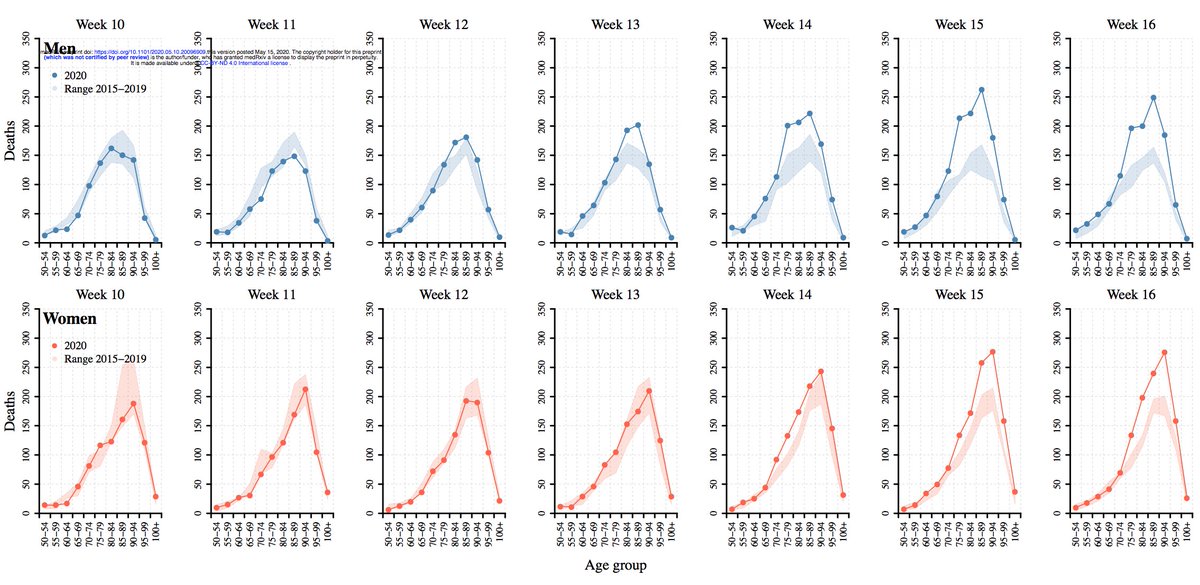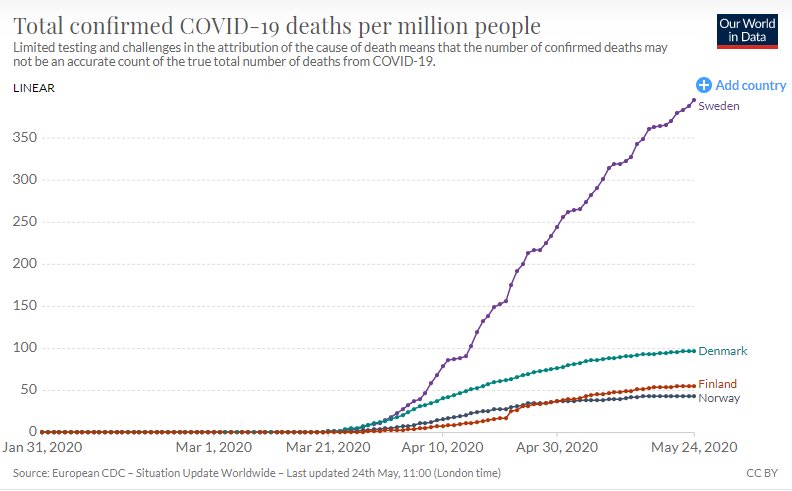There has been a lot of discussion of the Swedish approach to coping with the #COVID19 pandemic, and of whether their strategy of more voluntary restrictions and a more rapid approach to reaching ‘herd immunity’ would work. Let’s talk about the results so far. 1/
It’s been known for some time that the COVID19 death rate in Sweden was 3-7 times that of its similar Nordic neighbors, even if Sweden was doing better than many other countries with more severe restrictions, like the USA. https://www.economist.com/europe/2020/05/16/is-swedens-approach-to-covid-19-wise-or-reckless">https://www.economist.com/europe/20... via @TheEconomist 2/
Sweden banned gatherings of >50 people. Schools for kids <16 are open (older pupils tele-learn from home). Bars, restaurants, & gyms are open, w physical-distancing rules. People were asked to work from home if possible. Elderly were told to stay home. https://www.ft.com/content/31de03b8-6dbc-11ea-89df-41bea055720b">https://www.ft.com/content/3... 3/
Swedes themselves have *mostly* acted sensibly. Use of public transport has fallen significantly. A third of people say they avoid going to their workplace. Daily restaurant turnover fell by 70% in the month through April 22. But good behavior is hardly uniform. 4/
Sweden chose this path in some sense w reason, because absent a vaccine or total, hermetic isolation of a population, there& #39;s no way to avoid a plague like this. Plus, full lockdown is a stop-gap measure, to flatten the curve; some set of procedures must eventually replace it. 5/
But could the Swedes somehow miraculously thread the needle – and protect their vulnerable members while also allowing the pathogen to spread relatively unchecked in its population, building collective immunity without letting people die? (Figure from April 6.) 6/
Well, in this detailed & terrific new preprint via @karin_modig & @MaEbeling, the results are in. As expected, the price of this #COVID19 strategy is death. This is a sad truth about what happens when there is a deadly germ like SARS-CoV-2 circulating. https://www.medrxiv.org/content/10.1101/2020.05.10.20096909v1">https://www.medrxiv.org/content/1... 7/
This paper https://www.medrxiv.org/content/10.1101/2020.05.10.20096909v1">https://www.medrxiv.org/content/1... quantifies excess deaths in Sweden, week by week, starting in week 10 (in early March), for men and women, at all ages. The excess deaths, especially for men, become apparent by week 15, and are especially pronounced for older ages. #COVID19 8/
Excess deaths among all (adult) ages and both sexes increase as the pandemic progresses across time in 2020 in Sweden as the figure shows. Along with Italy, Spain, France, Belgium, and UK, Sweden has the highest rate of excess deaths in Europe at this time. 9/
The overall magnitude of the impact of the COVID-19 pandemic on human survival is mind-boggling. In rich, healthy, functional Sweden, it has already shaved 3 years of life expectancy for men and 2 years for women, this paper shows! https://www.medrxiv.org/content/10.1101/2020.05.10.20096909v1">https://www.medrxiv.org/content/1... 10/
The results in https://www.medrxiv.org/content/10.1101/2020.05.10.20096909v1">https://www.medrxiv.org/content/1... also highlight the astonishing gender disparity in the impact of COVID19, which strikes men so much harder than women. 11/
I need to clarify wording in #10 tweet in this thread re https://www.medrxiv.org/content/10.1101/2020.05.10.20096909v1.">https://www.medrxiv.org/content/1... The decline in life expectancy is estimated based on the impact of this pathogen being sustained, not just for its impact in the few months so far. | @adiwyner 12/
For more subtle analysis of the situation in Sweden, see this recent piece by Adele Lebanon from @BostonReview: Sweden’s Relaxed Approach to COVID-19 Isn’t Working http://bostonreview.net/politics/adele-lebano-sweden%E2%80%99s-relaxed-approach-covid-19-isn%E2%80%99t-working#.XsFOzZzPG_s.twitter">https://bostonreview.net/politics/... h/t @jcohen570 13/
Important COVID19 update today on Sweden, from official press conference: serology survey of ~1100 people from 9 regions during week 18, with sensitivity 98.3% & specificity 97.7% was completed. Age pattern is as expected but seroprevalence is low, alas. via @JacobGudiol 14/

 Read on Twitter
Read on Twitter








